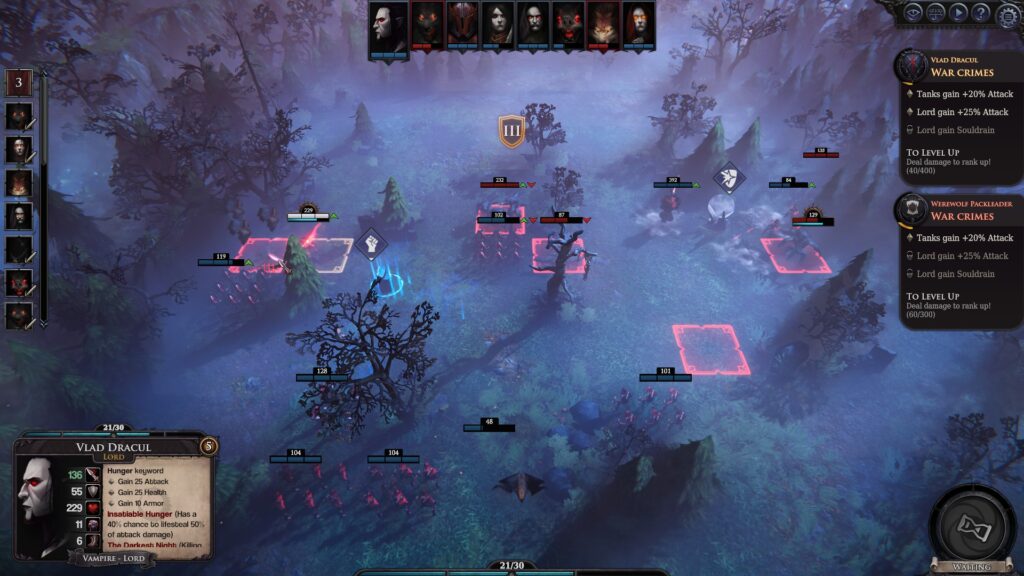
Immortal Realms: Vampire Wars is an upcoming strategy game by Palindrome Interactive and Kalypso Media that blends card mechanics, light 4X elements, and turn-based tactical battles. The game is currently running a closed beta for press and anyone who has placed a pre-order on PC. I’ve put around 8 hours into the beta so far, and here are my first impressions.
Immortal Realms: Vampire Wars is set in a medieval fantasy world, where rival vampire kingdoms rule over humans with an iron fist. The humans unlucky enough to live in a vampire kingdom are little more than slave labor, or cattle to be butchered to feed their bloodthirsty masters and their insatiable hunger.
It’s a relatively interesting idea for a fantasy setting, and the three vampire kingdoms draw from various vampire myths and tropes. All of my experience thus far is with the Dracul, a very militaristic vampire faction that draws heavily from the Transylvanian and Vlad the Impaler parts of vampire lore.
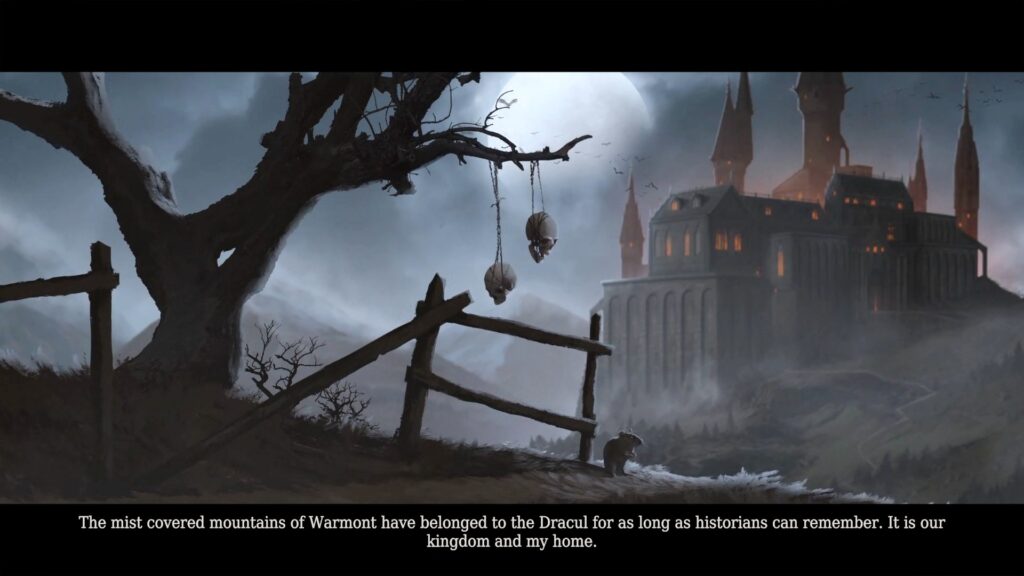
The game features a campaign for each faction, and I’m currently about halfway through the Dracul campaign. The story is delivered through short cutscenes and pop-up quips during a map. Unfortunately, the voice acting is hilariously bad so far. I hope you are ready for awkwardly delivered lines in bad Eastern Europeans accents, because you’ll be getting a lot of that here.
Immortal Realms is essentially a light 4X with an emphasis on card mechanics. Each map is divided into provinces that you’ll navigate with armies of units led by a lord. While you can have stacks that aren’t led by a lord, you lose access to a lot of the ways that you interact with provinces.
While there are small connecting provinces that have no inherent value beyond connecting your empire, most of a map’s provinces have some sort of building in them. Keeps are where you recruit your faction-specific units, forests let you recruit wolf packs, caves let you recruit bats, and so on.
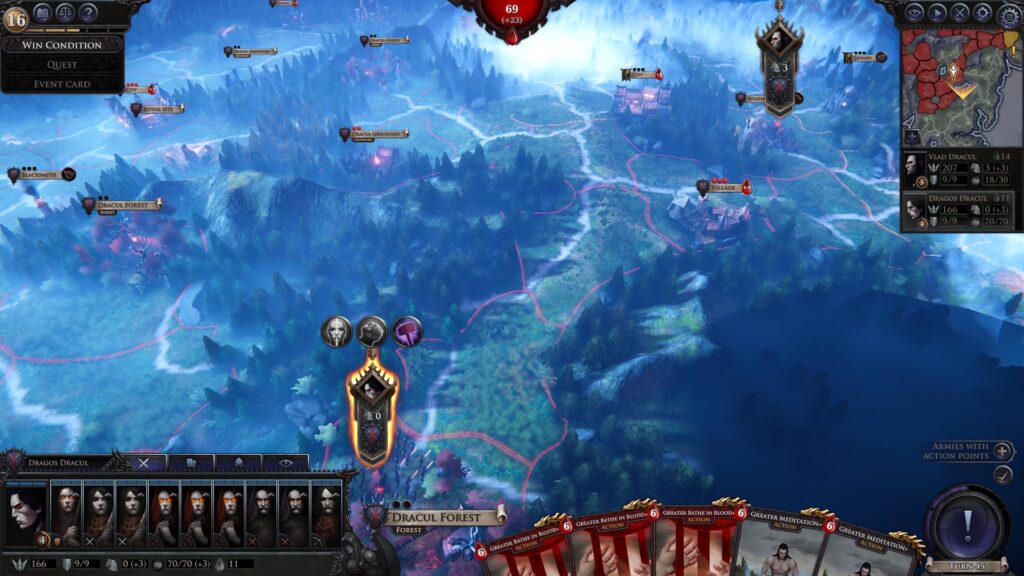
Villages and cities are where you get Blood, the game’s only real resource in the overworld map. The amount of Blood you get per turn is based on the population of each village or city you control. You can also heal your armies by resting at villages, and there are other context-sensitive actions like feeding, which reduces a village’s population to zero and gives you a set amount of Blood points per villager consumed.
Blood is used to recruit units, buy upgrades, play cards, and pay for army upkeep costs. Should you ever run out of Blood, your units will begin to lose health every turn.
Some other types of provinces, like blacksmiths, allow you to buy equipment cards for your lords. Libraries allow you to buy new cards, while wish stones let you choose from one of three special effects. Most of these special actions can only be taken once per year, with a year passing every four turns.
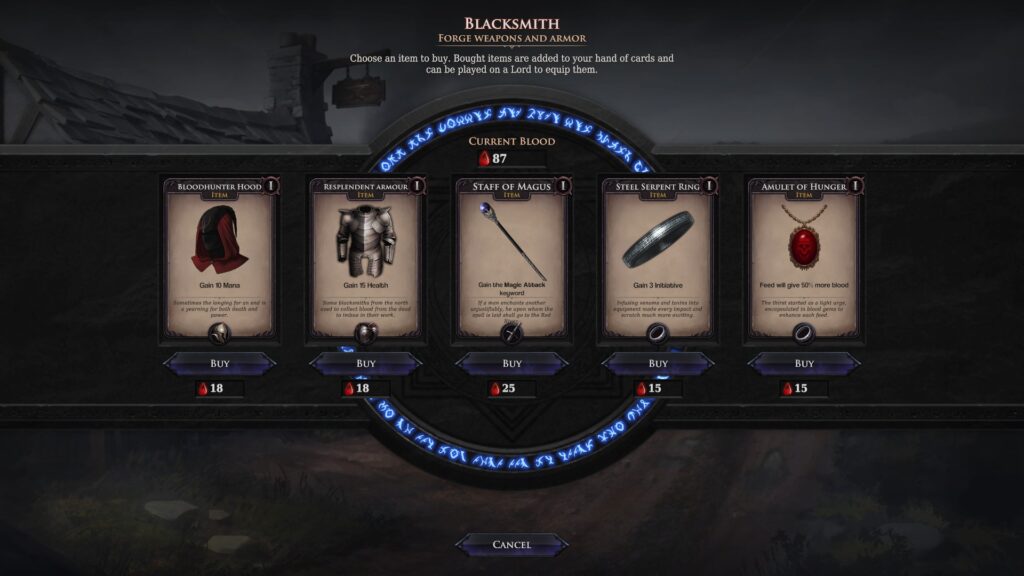
As I said earlier, an army led by a lord is required to do many of these actions. Each army stack has several action points that can be used to move around the map and take context-sensitive actions. Armies led by lords typically have three or four, while other stacks have two.
Almost all of your empire management is done through this action point system. This includes upgrading provinces, which is something I’m not too keen on. This means that you’ll often need to backtrack to provinces you conquered earlier in the game to upgrade them, once you have a better economy.
There is also a skill tree system for your empire, called Legacies. You gain experience by conquering territories and winning battles, which earns you skill points that you can put into different passive abilities across three paths.
In the case of the Dracul clan, one branch in based around giving passive buffs to your lords, one enhances your units, and the last one has buffs associated with your empire.

Most of these are fairly basic, like increasing the stats of specific units, or reducing the cost of upgrades. Some, however, can be fairly drastic. Labor Slaves, for example, means that constructing upgrades no longer requires action points.
I keep mentioning the game’s card elements, so maybe I should explain them. You start each game with a hand of cards that represent various special abilities. These all cost Blood to play, and can have some very useful effects. Some might heal all units in an army, while others might increase a city’s population, or allow you to buy an upgrade or recruit a unit at a reduced cost.
Those last two examples of cards bypass the usual requirement of having a lord present at the province that you are upgrading, so there are ways to somewhat negate this otherwise annoying mechanic in the game’s empire management system.
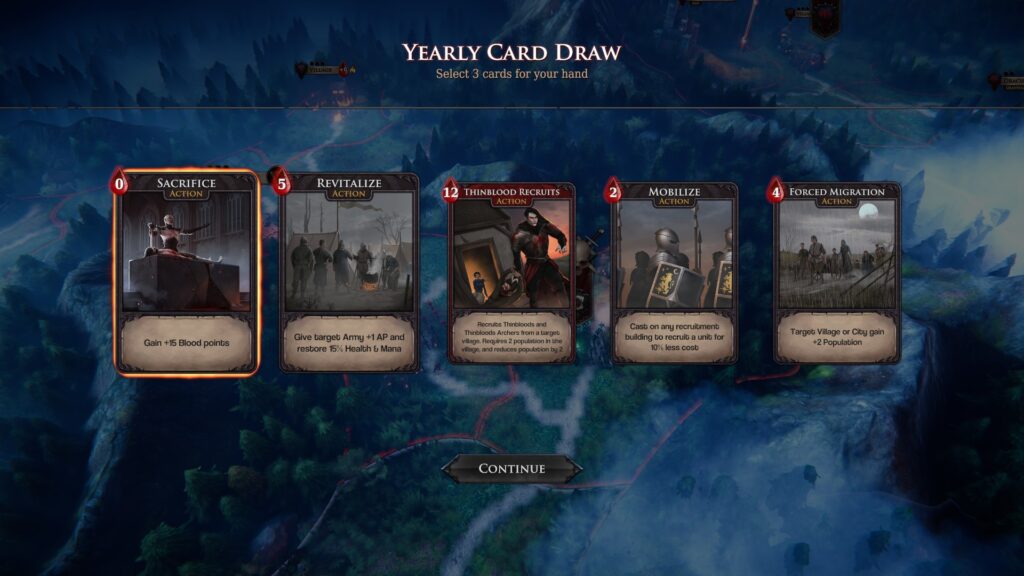
Every four turns you are given a chance to draft three new cards from a selection of five. You’ll also gain cards from the libraries I mentioned earlier, as well as conquering certain territories or winning battles. You can upgrade your cards by capturing certain ritual site provinces scattered around a map.
For all intents and purposes, the card system basically works kind of like magic in a game like Age of Wonders. The card system ensures that there is another degree of resource management, as you must figure out when is the best time to use your cards, and what cards are the most useful drafts for your current situation.
The game’s combat system is your fairly standard turn-based tactics affair. An army can consist of a lord and up to nine units. When you enter combat, you are brought to a randomly generated map where you’ll deploy your units.
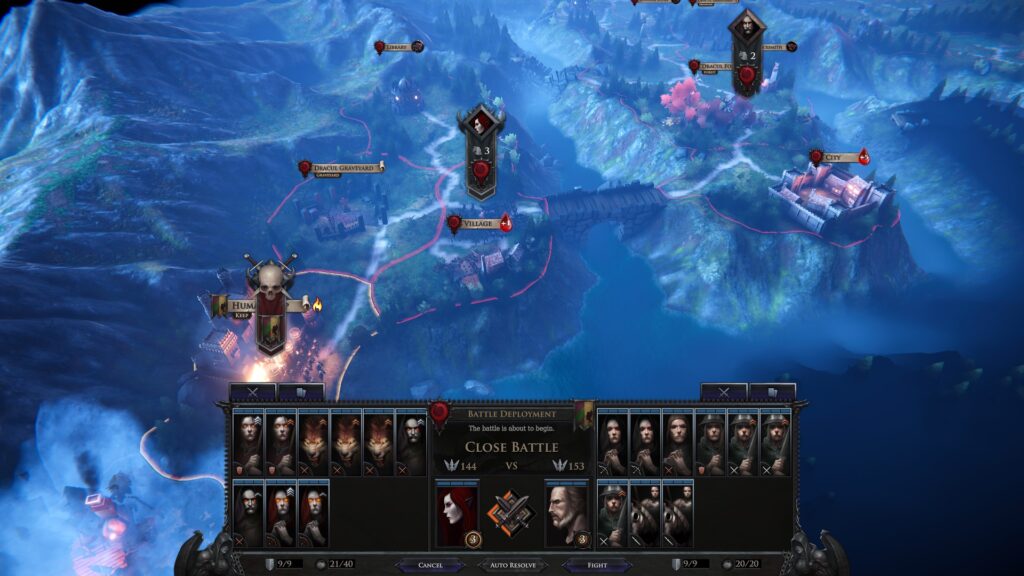
While most 4X games tend to have a battle system where you take turns activating your entire army, Immortal Realms has an initiative system that determines when units activate. If you’d rather hold off activating a particular unit though, you can select a wait action and come back to them at the end of the round.
While melee units can move and attack, ranged and support units must choose to either attack, perform an action, or move. Each unit also has a cooldown-based special ability. Acolytes can heal friendly units, while wolves can perform a lunge that allows them to attack an enemy unit diagonally without triggering a retaliation attack.
The combat heavily focuses on positioning and flanking maneuvers. If you have a unit engaging an enemy unit, you can deal extra damage by attacking them from the sides or the rear. Outside of these specific examples though, unit facing doesn’t actually matter.
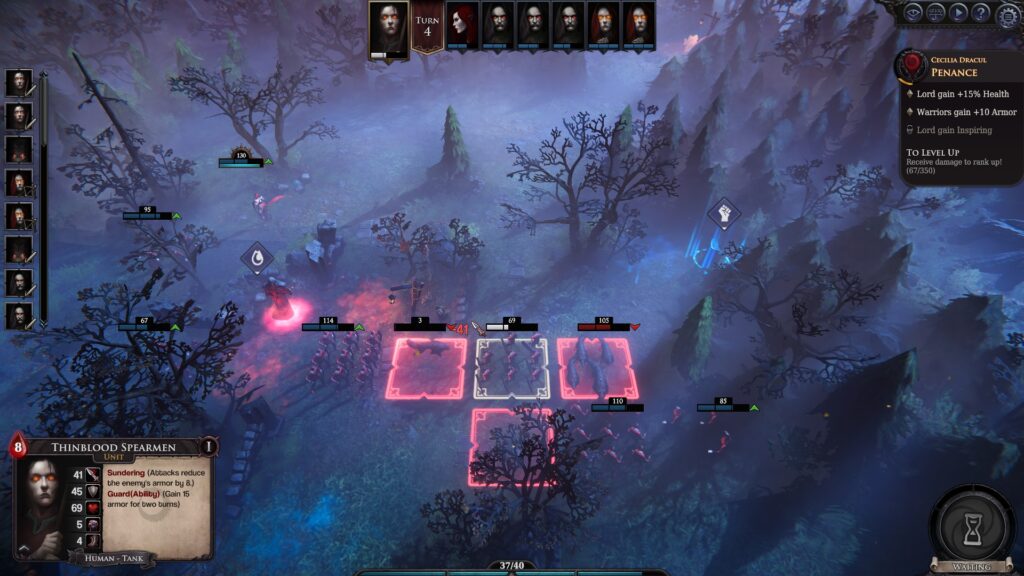
Besides being a powerful hero unit, lords also bring along a hand of spell cards. These cards cost mana from the lord’s personal reserves to cast, and have a cooldown before they can be used again.
As your lord levels up, they can unlock new spells, or upgrade spells they already know. The lord’s overall stats, abilities, and spells are based on their class.
The game’s combat mechanics are fairly decent overall, but there are certainly things that need to be fixed before full release. When enemies play their spell cards you get a tiny, illegible image like the one below.
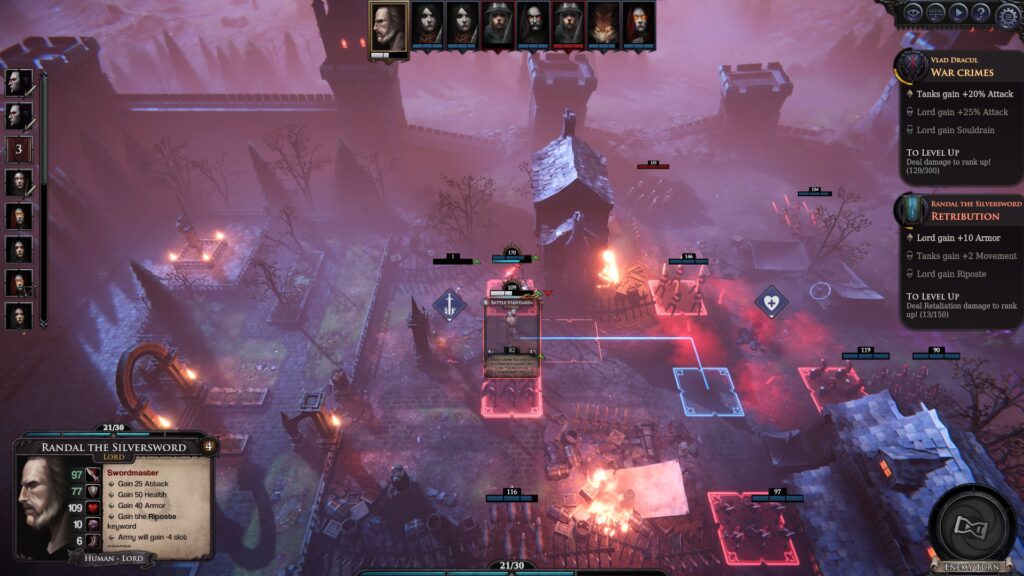
In fact, there are many areas of the UI in general that are small and clunky. The game often won’t acknowledge that you played a spell or equipped an item until you’ve de-selected an army, and reselected them again.
I also feel that the battlefields are often a bit too littered with terrain and objects, which makes them feel too small and confined at times. Many maps have cluttered chokepoints that devolve into grinding melees against two units because you can’t fit anymore in.
This makes it hard to effectively flank or maneuver. Some of the most egregious examples result in maps that are effectively two or three “lanes” that only one unit can squeeze through at a time.
As a long-time fan of tactical games, I also think there should be a penalty for leaving melee like many other games have. As it stands right now, units can freely disengage and run off to a whole different fight without any consequences. Most games have some sort of a “free strike” system, and I think Immortal Realms could benefit from something like that as well.
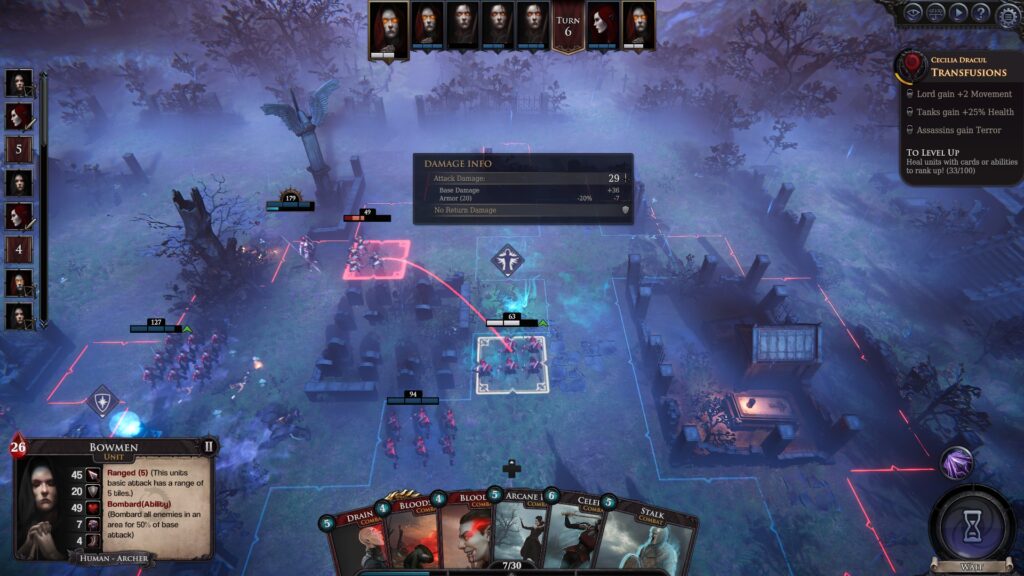
The AI can also be pretty hit or miss. It’s not uncommon for a roaming enemy army to attack a stack that is three times their size, effectively throwing their troops away to die.
The AI in battles isn’t much better. Sometimes they’ll effectively focus down weakened units, while other times they might completely ignore a unit near death to attack something else. They can also pick some rather bizarre targets for their spells, too.
While Immortal Realms does have some clunky mechanics and UI problems here and there, I’ve enjoyed what I played so far. A lot of my complaints are being echoed by other people in the beta, and hopefully Palindrome Interactive will take this feedback to heart before the game receives a full release.
Immortal Realms: Vampire Wars launches August 28th for Windows PC (via Steam), Nintendo Switch, PlayStation 4, and Xbox One. If you want to play it sooner, you can gain instant access to the closed beta by pre-ordering.
Immortal Realms: Vampire Wars was previewed on Windows PC using a preview copy provided by Kalypso Media. You can find additional information about Niche Gamer’s review/ethics policy here.